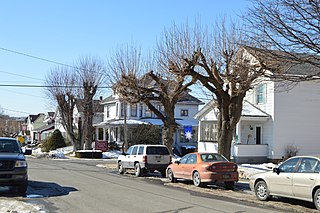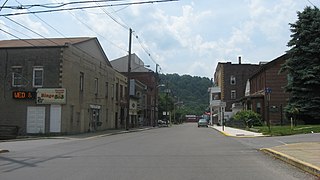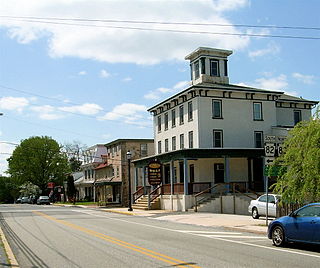
Tamaqua is a borough in eastern Schuylkill County in the Coal Region of Pennsylvania, United States. It had a population of 6,934 as of the 2020 U.S. census.

Manayunk is a neighborhood in the section of Lower Northwest Philadelphia in the state of Pennsylvania. Located adjacent to the neighborhoods of Roxborough and Wissahickon and also on the banks of the Schuylkill River, Manayunk contains the first canal begun in the United States.

The Roaring Spring Historic District is a national historic district that is located in Roaring Spring, Blair County, Pennsylvania.

The Williamsburg Historic District is a national historic district that is located in Williamsburg, Blair County, Pennsylvania.

Mount Union Historic District is a national historic district located at Mount Union in Huntingdon County, Pennsylvania. The district includes 58 contributing buildings, 3 contributing sites, and 1 contributing structure in the central business district and surrounding residential areas of Mount Union. Notable buildings include the Federal-style John Shaver House (1818), Shapiro Theater (1915), T.A. Appleby Store and House, Kenmar Hotel, Penn Central National Bank (1916), Peduzzi's and the Weller Building (1913-1914), Pennsylvania Railroad Freight Depot (1914), St. Luke's Evangelical Lutheran Church (1904-1905), First United Methodist Church (1925-1926), St. Catherine of Siena Roman Catholic Church (1912-1913), Mount Union Elementary School (1923-1924), and U.S. Post Office (1936). The contributing sites include the I.O.O.F. community cemetery, founded in 1872, and the former Victoria Park. Located in the district and listed separately is the Harbison-Walker Refractories Company complex.

The Portage Historic District is a national historic district that is located in Portage in Cambria County, Pennsylvania.

The Stoystown Historic District is a national historic district that is located in Stoystown in Somerset County, Pennsylvania.

The Red Lion Borough Historic District is a national historic district that is located in Red Lion Borough in York County, Pennsylvania.

The Manheim Borough Historic District is a national historic district that is located in Manheim, Lancaster County, Pennsylvania.

Upper Roxborough Historic District is a national historic district located in Philadelphia and Whitemarsh Township, Montgomery County, Pennsylvania. It encompasses 108 contributing buildings, 23 contributing sites, and 18 contributing structures in Upper Roxborough. The district includes a number of small scale farm and industrial workers' housing, estate houses, mill-owners' dwellings, and farm buildings. Notable buildings include the Shawmont Railroad Station (1834), Miquon Station designed by Frank Furness (1910), Riverside Paper Mills, Hagy's Mill ruin, St. Mary's Church, and "Fairview" and other buildings on the grounds of the Schuylkill Center for Environmental Education. The Roxborough Pumping Station was also part of the district, but it was demolished in 2011 after sitting abandoned for over fifty years.

The Pine Grove Historic District is a national historic district located in Pine Grove, Schuylkill County, Pennsylvania. Added to the National Register of Historic Places in 1987, it encompasses 1,770 acres, 233 contributing buildings, one contributing site, and one contributing structure in a residential section of Pine Grove, and is bordered by South Tulpehocken and Mill streets and the Swatara Creek.

The Lewisburg Historic District is a national historic district that is located in Lewisburg, Union County, Pennsylvania.

Emlenton Historic District is a national historic district located at Emlenton, Venango County, Pennsylvania. The district includes 317 contributing buildings, 57 contributing structures, and 1 contributing object in the central business district and surrounding residential areas of Emlenton. It includes commercial, residential, industrial, and institutional buildings. They are in a variety of popular architectural styles including Italianate, Greek Revival, and Gothic Revival.

The Mount Pleasant Historic District is a national historic district that is located in Mount Pleasant, Westmoreland County, Pennsylvania.

The West Chester Downtown Historic District is a national historic district that is located in West Chester, Chester County, Pennsylvania, United States.

Elverson Historic District is a national historic district located in Elverson, Chester County, Pennsylvania. The district includes 133 contributing buildings, 3 contributing sites, and 4 contributing structures in the central business district and surrounding residential areas of Elverson. The district includes a variety of residential, commercial, and institutional buildings with examples of Bungalow/craftsman, Georgian, and Gothic Revival architecture. Contributing buildings date from about 1750 to about 1930. Notable buildings include "The Bank House", train station (1870), Springfield M.E. Church (1869), Blue Rock Hotel (1860), Dengler Bro. Store, Whoye Horse Tavern (1811), The Creamery (1906), and Springfield School (1873). One of the contributing structures is the railroad car "Baltimore County."

The Pottstown Landing Historic District is a national historic district that is located in North Coventry Township, Chester County, Pennsylvania.

The Oxford Historic District is a national historic district that is located in Oxford, Chester County, Pennsylvania.

Reidsville Historic District is a national historic district located at Reidsville, Rockingham County, North Carolina. It encompasses 324 contributing buildings, 1 contributing site, 11 contributing structures, and 1 contributing object in the central business district and surrounding residential sections of Reidsville. It was developed between about 1865 and 1941, and includes notable examples of Italianate, Queen Anne, American Craftsman, and Classical Revival style architecture. Located in the district are the separately listed Penn House and Gov. David S. Reid House. Other notable buildings include the Oaks-Motley House, Colonel A. J. Boyd House (mid-1870s), Reid Block (1880s), Citizens' Bank Building, William Lindsey and company Tobacco Factory, First Baptist Church, Main Street Methodist Church, Melrose (1909) designed by architect Richard Gambier, R. L. Watt house designed by Willard C. Northup, First Presbyterian Church (1922), St. Thomas Episcopal Church, Grand Theatre, Belvedere Hotel, United States Post Office and Federal Building, and the Municipal Building (1926).

The Palmerton Historic District is a national historic district located in Palmerton, Carbon County, Pennsylvania. Bordered roughly by Tomb Street, Avenue A, 8th Street, and Harvard Avenue, it encompasses 1,262 contributing buildings, seven contributing structures, and four contributing sites, as well as 475 noncontributing buildings and 13 noncontributing sites where previously demolished resources had been located. Usage functions range from commercial and industrial to institutional to residential in nature. This district was added to the National Register of Historic Places on January 19, 2018 in recognition of its significance in community planning and development.
























